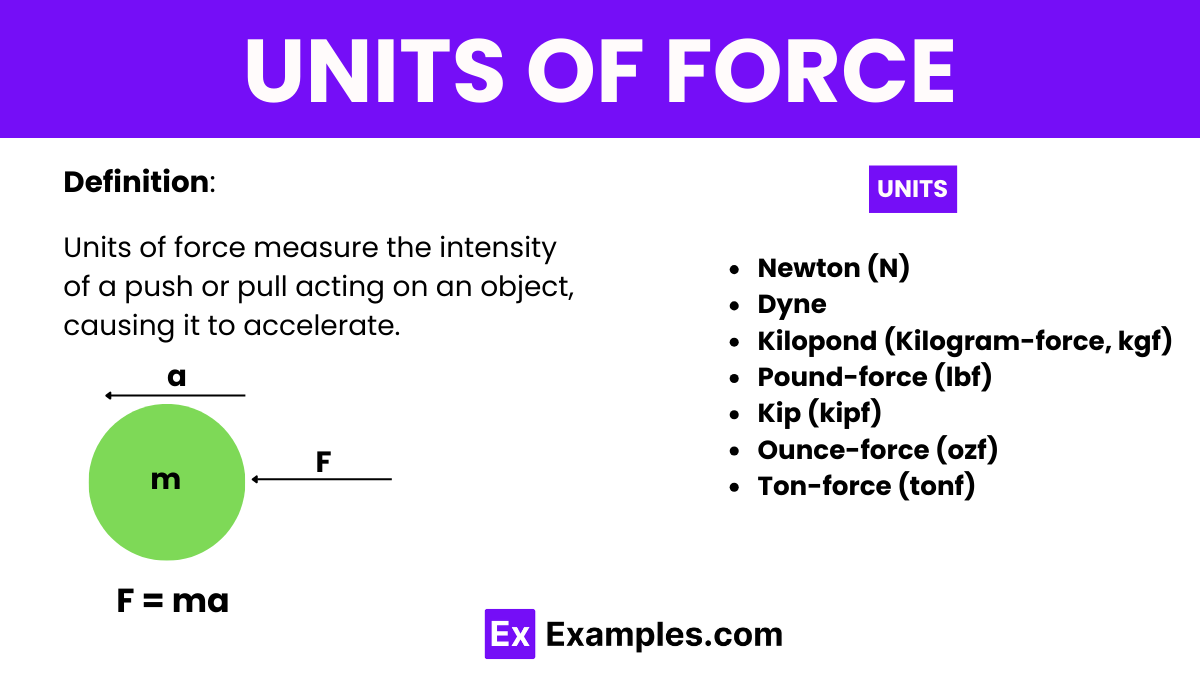What is the SI unit of force?
Pascal
Joule
Newton
Watt


Units of force measure the intensity of a push or pull acting on an object, causing it to accelerate. The most commonly used unit is the Newton (N), defined as the force necessary to accelerate a one-kilogram mass by one meter per second squared. Other units include the dyne, used in the centimeter-gram-second (CGS) system, where one dyne is the force needed to accelerate a one-gram mass by one centimeter per second squared. Additionally, the pound-force (lbf) is used in the imperial system, equivalent to the force exerted by gravity on one pound of mass. Each of these units reflects the effect of force within different measurement systems.
Newton (N) is the standard unit of force in the International System of Units (SI). It is named after Sir Isaac Newton, in recognition of his work in classical mechanics. A Newton is defined as the force required to accelerate a one-kilogram mass at a rate of one meter per second squared (1 m/s²).
The Newton (N) serves as the SI unit of force. It derives its name from Sir Isaac Newton, whose laws of motion laid the groundwork for classical mechanics. The definition of one Newton is quite specific: it is the force required to accelerate a one-kilogram mass at a rate of one meter per second squared.
Start by considering Newton’s Second Law of Motion, which asserts that the force acting on an object is a product of its mass and the acceleration it undergoes. This law is mathematically expressed as
Here, F represents force, m denotes mass, and a signifies acceleration.
When you merge the units of mass and acceleration, the resulting unit of force emerges:
This combination of kg·m/s² precisely defines one Newton (N). Thus, a Newton is the force necessary to accelerate a one-kilogram mass at a rate of one meter per second squared.
Here’s a table listing various units of force, presented in the same format you requested:
| Unit of Force | Symbol |
|---|---|
| Newton | N |
| Dyne | dyn |
| Kilopond | kp |
| Pound-force | lbf |
| Kip | kip |
| Ounce-force | ozf |
| Ton-force (metric) | tf |
| Ton-force (short, US) | tonf |
The Newton is the SI unit of force named after Sir Isaac Newton. It measures the amount of force required to accelerate a mass of one kilogram at a rate of one meter per second squared. This unit is universally used in science and engineering to quantify force.
A dyne is the unit of force in the centimeter-gram-second (CGS) system of units. It measures the force needed to accelerate a mass of one gram by one centimeter per second squared. It is primarily used in physics, particularly in contexts involving small forces.
Also known as a kilogram-force (kgf), the kilopond measures force as the gravitational force exerted by a one-kilogram mass at Earth’s surface. It is used historically in engineering and still appears in some contexts, like rocketry and engine specifications.
The pound-force is the unit of force in the imperial system, predominantly used in the United States. It measures the force exerted by gravity on one pound of mass. This unit is common in automotive and aerospace industries, as well as many fields of engineering and physics in the U.S.
A kip is a unit of force used primarily in engineering to measure large forces, such as loads in building and bridge materials. It is equal to 1000 pounds-force and is common in architectural and engineering specifications, especially in the United States.
The ounce-force is a smaller unit of force in the imperial system, used to measure smaller forces. It is often used in applications like measuring the force of springs and other light force applications.
The metric ton-force is a unit of force based on the gravitational force exerted by a metric ton (1000 kilograms). It is occasionally used in engineering and industrial applications, particularly outside the United States.
The short ton-force is used in the United States and is based on the gravitational force exerted by a short ton (2000 pounds). It’s applied in industries like shipping, construction, and other areas where large forces are measured.

| Force Unit | Newton (N) | Dyne (dyn) | Kilopond (kp) | Pound-force (lbf) |
|---|---|---|---|---|
| Newton (N) | 1 | 100,000 | 0.10197 | 0.22481 |
| Dyne (dyn) | 0.00001 | 1 | 1.0197E-6 | 2.2481E-5 |
| Kilopond (kp) | 9.80665 | 980,665 | 1 | 2.20462 |
| Pound-force (lbf) | 4.44822 | 444,822 | 0.45359 | 1 |
Firstly, one of the primary effects of force is the acceleration of an object. According to Newton’s Second Law of Motion, a force applied to an object causes it to accelerate in the direction of the force. This relationship is expressed as F=m × a, where F is the force applied, m is the mass of the object, and a is the acceleration.
Additionally, force can change the velocity of an object. This change might involve an increase or decrease in the speed, or a change in direction, or both. For instance, when a car speeds up, slows down, or turns, it is experiencing different forces that alter its velocity.
Moreover, forces can cause deformation. When a force is applied to an object, it may change shape temporarily or permanently, depending on the material properties of the object and the magnitude of the force. Elastic deformation occurs when the object returns to its original shape after the force is removed, while plastic deformation results in permanent changes.
Furthermore, force is instrumental in changing the state of rest or motion of an object. An object at rest will move if a force is applied, and a moving object will come to rest when a force opposes its motion. This effect is crucial in numerous mechanical systems and devices.
In addition, forces play a key role in creating equilibrium conditions. When the net force acting on an object is zero, the object is said to be in a state of equilibrium, meaning it either remains at rest or moves with constant velocity. This principle is vital in statics and dynamics, fields concerned with analyzing forces in systems at rest and in motion, respectively.
Contact forces are those that require physical contact between two interacting objects. They are predominant in everyday phenomena and mechanical operations. Key examples include:
Non-contact forces, also known as action-at-a-distance forces, occur even if the interacting objects are not physically touching. These forces can act over a distance through a field. The primary types include:
Units for measuring the impact of force include the Newton (N) for direct force, Pascals (Pa) for pressure, and Joules (J) for energy transferred during the impact.
No, Joules is not a unit of force. It is the unit of energy, work, or amount of heat, measuring the impact of a force over distance.
The unit of force is called the Newton (N), named after Sir Isaac Newton to honor his groundbreaking work in developing the laws of motion and gravity.
Text prompt
Add Tone
10 Examples of Public speaking
20 Examples of Gas lighting
What is the SI unit of force?
Pascal
Joule
Newton
Watt
One newton is equivalent to which of the following?
1 kg·m/s²
1 kg·m²/s
1 kg·s²/m
1 m/s²
Which instrument is commonly used to measure force?
Thermometer
Voltmeter
Spring balance
Hygrometer
Which of the following units is not a unit of force?
Newton
Dyne
Pound
Joule
How many dynes are there in 1 newton?
100
1000
10,000
100,000
What is the CGS unit of force?
Newton
Dyne
Erg
Pascal
If an object is acted upon by a force of 50 N and it moves 2 meters in the direction of the force, what is the work done?
25 J
50 J
100 J
200 J
Which of the following correctly describes 1 pound-force (lbf)?
The force required to accelerate a 1 kg mass by 1 m/s²
The force required to accelerate a 1 lb mass by 9.8 m/s²
The force required to accelerate a 1 kg mass by 9.8 m/s²
The force required to accelerate a 1 lb mass by 1 ft/s²
Which of the following pairs correctly matches the unit with the quantity?
Newton - Work
Dyne - Energy
Pascal - Pressure
Watt - Force
How much force is needed to accelerate a 20 kg object at 2 m/s²?
10 N
20 N
40 N
60 N
Before you leave, take our quick quiz to enhance your learning!

